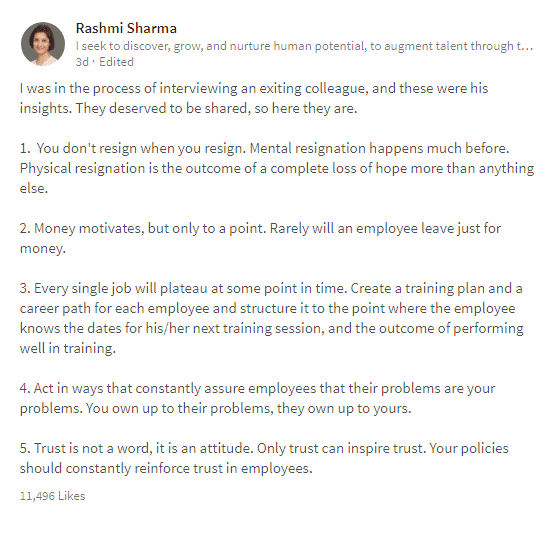It is no brainer why Google, Facebook, Apple make to every list of top 10-100 companies to work. These are the names revered not just for innovation but for their work culture, trust and people policies. And, who’s behind them to ensure they build it, and build it right? Human Resource- is the answer; they are the superheroes who make things work.
People in this department are responsible for founding each layer right to nurture Trust, Growth and Culture of an organization. Be it Facebook, Apple or any size business around the world, Human resource management is the paladin of organizational values- it is this department that companies hold responsible for their growth and harmony. For decades, their role was largely identified with compliance based work and record keeping but that’s changing with technology in their hands. They can handle traditional responsibilities in a faster and better way, so HR managers of this era are known as People Manager, L&D Expert, Culture Expert, Talent Acquisition Manager, Headhunters, etc.
Let’s take a look at the major responsibilities around which HR goals are established.
-Recruitment & Training
-Ensuring Compliance with Laws
-Salary Determination, Performance Review and Appraisal
-Employee Engagement
-Policy Development
-And, this,
-This,
-And, more…
The list is long.
The role and responsibilities of HR may outwardly seem like some plus-minus game, but the challenges involved and the goals set by organizations make it nothing short of an ordeal. It’s neither about “just” managing people. The function of an HR manager in this day and age is more about fostering trust, growth and great culture in an organization.
So hiring an HR manager should not be just about searching for a well-groomed MBA with a decked out CV. They will end up playing chatbots who says ‘Hi’ before you try to reach out, and keeps giving answers nowhere close to the question.
Bonus for HRs: Don’t be the talkbot employees love to hate- you can be their superhero.
To become an organized body of people functioning for a collective goal, it’s a must to have few policies in place. The set of formal rules and guidelines helps HR department hire, train, assess, and reward employees. Apart from facilitating smooth functioning, policies lead to perception. And, who’s responsible for the implementation of policies- none other than the HR department.
Now the question is- Who’s that ideal human resource manager for this significant role in an organization? Certainly someone who can trounce the chatbot notions and universally cracked jokes (beliefs and complaints) about HRs.
What does it take to be the one?
This question is not just for the companies searching for HRs but for those too who see human resource as a career and aspire to reach the heights of success in this vertical. Working as a part of the human resource department calls for more than the structural eligibility.
An HR is a people person who,
- knows the nuances of communication and sees organizational values as sacrosanct
- can align themselves with the Vision, Mission, and Objectives of the organization
- thinks (and acts) knowing that each of their actions lead to creating a work environment
Human resource departments bereft of the above-said skills and approach are as good as elevators with no buttons.
One has to be a living combination of Attitude, Competence, and Execution to deliver what the role of HR truly asks for. And, this applies to most of the areas- strategic, operational, succession or any other sorts.
Attitude
It’s the attitude of HR personnel that makes them act right in the worst of conditions; be it handling the acidic employees or listening to day-to-day rants. All of HR’s role, responsibilities boil down to one action- doing the right thing, at the right time, with the right people.
Competence
Competence is a vast terrain and subject to individual skills, exposure and knowledge. When it comes to HR, you can term it as the ability to manage, technical expertise unique to an organization, behavior, judgment ability, quality control, reliability, problem solving ability, etc. Competence enables one to take actions in various circumstances, thereby making the job easier.
For example, if you have a plan or an idea that you think is needed at this hour, you must also have the ability to get the top management buy into it. Being in the position of HR manager, you are responsible for settling people issues, formalizing policies and bringing changes to facets that can halt company’s growth. As a human resource manager, you should know-
- When is the time to warn and reward?
- Who needs to stay and who should be shown the exit door?
- What kind of skills are required to achieve organizational goals?
- When is the right time to hire?
- When (and Why) someone seems to be disengaged?
- When employees are not aligned with organization’s Vision/Culture/Objectives?
- Who’s the bad apple that’s killing the company culture?
- Which initiatives need to be taken to drive team performance?
Disciplined execution
Disciplined execution is a must in all areas- be it holding regular meetings or performance reviews. Your constant efforts will result into small accomplishments everyday leading to the big picture. When you’re taking a new employee through or interviewing an applicant, it’s your responsibility to make it an experience worth cherishing EVERY TIME.
Complying with policies and nurturing behaviors is a constant job. Even if you are on it diligently, it may go unnoticed at times. But, one job, one task, one guideline that you miss in process, will never go unnoticed- that’s how the job of HR is. The tasks missed, undelivered or vainly carried dismantle set processes and such constant misses eventually impact an organization as a whole.
Not just the building block of an organization, HRs are the connecting link between employees and employer
As an HR representative, you will get various moments when you can paint the employer image in employees’ minds and this is when you introduce your organization to them. Be it an exit interview or a warning, you can make the most of it to lay a strong company foundation. Hear it from Human Resource Advisor, Rashmi Dixit, about important insights she drew from an exit interview (the image below).

Culture
HRs is the connecting link between employees and employer. It’s their duty to ensure that each member of the company is also growing along with organizational growth. For long term sustenance and growth of an organization, it’s important that employees feel valuable and like a part of company’s journey. By ensuring their growth, a company takes its first step towards breeding trust. Everything from perks, feedbacks, appraisals to retentions, plays major role in it, and since everything is handled by HR department, it’s their ability to deliver as per the set goals, that matters.
An organization invests in HR because it’s this department that dedicatedly takes the charge of inculcating values and fostering a culture. In due course, this culture makes it easier for top management to keep multiple people aligned with company goals.
Good work culture also breeds loyalty and oneness, which is the most significant factor for scaling up. For instance, whenever you send out a new message to your employees, you want to be heard and understood by all in one way. No organization can expect to be heard by 100s-1000s of people at once, in the same way. But, if they’ve some connectivity and commonality, it will pass through most of the employees in their own informal networks (and ways). You can’t imagine to have 100/100 people contributing to a healthy work culture, but thinking about 50/100 is but a necessity. You can’t afford to have less than it. Hiring leaders and such 50 links is the major responsibility of HR department.
Conduct
HRs maintain discipline in many ways and it’s their actions, their association with employees that keeps employees connected with their employer. So their conduct matters a lot. How HRs come across an employee makes a difference to their day to day conversations and engagements.
Few More Tips For HRs
- Take your demeanor seriously- keep it deferential yet decidedly determined.
- Improve quality of hiring strategy so that more smart and talented people desire to be hired- make the employer brand strong.
- There will always be people trying to crumble your morale- stay positive and immune from those few.
- Let them know- it’s embarrassing. If something is inappropriate, let them know, “your feedback/request is difficult to discuss”. Don’t make it more awkward by falling short of words.
- Never delay tough decisions and hard conversations- it’s human nature to want to delay having a tough conversation with an employee with a bad attitude. But that only makes things worse.
- Always put emphasis on the positive- even the negative conversations have a purpose that will positively affect your organization so focus on that only.
- Let people rant a bit- you’ll regularly come across people who will try to justify or defend something after you’ve finished. Let them do a bit and don’t bother about it- you’ll lose nothing and they’ll feel heard.
- Don’t overuse “You” in conversations- using “you” in conversations (especially the bitter ones) will only drag the conversation and within seconds you might find yourself struggling to come out of that black hole of conversation.
“You” puts responsibility on the person and invites for a fight. It’s OK to use it once or twice but don’t overexploit it if you want to avoid negativity.
Instead of saying, “You take too many leaves and it’s known to everyone in the company”, say, “We need to discuss your leave habits as that’s becoming a serious issue”.
- Meet your team regularly- It helps keep everyone on the same page. Personal meetings are important, be it within HR department or of HRs with other teams. It may sound cliché as meetings to most of us mean boring agendas and typical conversations- but they aren’t. Patrick Lencioni defines it the best in his book ‘Death By Meeting’. He says,
“The greatest myth that exists about meetings is that they are inherently bad…But the fact is, bad meetings are a reflection of bad leaders.”
Another one by him, “bad meetings start with the attitudes and approaches of the people who lead and take part in them”
So again, it’s your attitude and approach that makes the difference.
- Keep your mails/ conversations result oriented- try using, “I’m bringing this up because…” instead of beating about the bush while talking out a matter or communicating something important.
In the end, we must admit that a company is made of people, not policies. Accomplishment of organizational goals totally depends on your workforce, their attitude, their competence and their willingness. So whatever structure you create to make multiple people work toward certain end has to be people focused. If you want to be big, build a company, if you want to be successful build your team. To have creative, diligent and focused people on team, first invest in your HR department as they are the ones actually participating in their training, hiring, retention (or firing for that matter). They choose the people who will lead your workforce tomorrow, so they must be aligned with your goals first.



